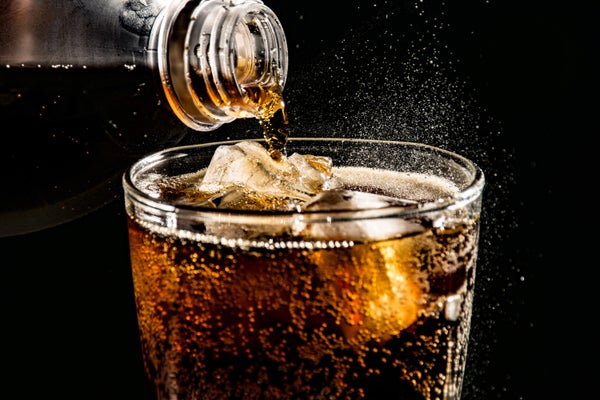This article was published in Scientific American’s former blog network and reflects the views of the author, not necessarily those of Scientific American
The original recipe for Coca-Cola is said to be one of the most closely guarded secrets in the world. There are claims that only two people know it at any given time and can never travel on the same plane in case it crashes. Part of Coca-Cola’s appeal is its intentionally hyped secrecy; the formula is kept in a vault that even Liberace might consider to be over-the-top.
Is it one of the most guarded secrets or has the original formula actually just been available--hiding in plain sight? An episode of This American Life explored the possibility that it was included in a newspaper column published in the Atlanta Journal and Constitution on February 18, 1979.
Coca-Cola completely rejects the authenticity of this version. Here is a clarification from This American Life:
On supporting science journalism
If you're enjoying this article, consider supporting our award-winning journalism by subscribing. By purchasing a subscription you are helping to ensure the future of impactful stories about the discoveries and ideas shaping our world today.
To be clear: We are not claiming that we have found the recipe used today for Coca-Cola. We believe we found a recipe that is either the original recipe made by the inventor of Coke, John Pemberton, or a version of Coca-Cola that he made either before or after the product hit the market in 1886. We believe that because it was found in the notebook of his friend, on a page entitled "Coco-Cola recipe improved," and because it was found in Pemberton's own notebook, in Coca-Cola's archives.”
As many know, the most addictive part of the original Coca-Cola formula may not have been all its sugar. The drink’s inventor, Dr. John Stith Pemberton, became a morphine addict following an injury he received during the Civil War. His drink included fluid extract of coca, caffeine packed kola nuts, and sugar to mask their bitter taste. Pemberton began selling Coca-Cola in 1886 and contained fluid extract of coca until 1903--although its removal was much more complicated than the substance becoming illegal. (It did not become illegal until 1914.) Coca leaves are illegal in the United States; however, the company still uses them after they have been “de-cocainized” by Stepan Chemical Company in Maywood, New Jersey.
Coca leaves are available to order online, with some of the sites offering the option to purchase by phone. Ordering coca via a cell phone? That does not seem like the best idea.
Why yes, I am, in fact, this paranoid without the coca.
After doing some research, it seems coca leaves are completely illegal. Although some say enforcement is not so strict, this is not something I’d like to find out (or recommend others do, either). Plus, the flavor is unaffected by the omission and the language used in the instructions to make it are mildly confusing.

The “original” recipe begins by making the 7X. It’s a combination of oils--cinnamon, orange, neroli, nutmeg, cilantro, lemon--and it’s essential to not use essential oils that are not food grade. Make sure they are food grade since other kinds are not for ingestion. Extracts are much stronger than they were when the recipe was invented. Only a small amount is required. They can be measured with a pipette/eye dropper, but I found a medical syringe to be a very easy and precise alternative. These oils are thoroughly blended with pure ethanol alcohol, which acts as an emulsifier. Pure alcohol can be difficult to find, so a high quality alcohol such as vodka can substitute.

Next, part of the sugar is used to make caramel. (David Lebovitz has some useful instructions on how to make the perfect caramel.) The remaining sugar is mixed with water, cooked over a stove in the same way that you would make a simple syrup--brought to a boil then simmered over medium low heat for about three minutes. Combine the sugar syrup with the caramel.

Then, the sugar syrup-caramel mixture is combined with a few other ingredients, including lime juice and vanilla. The recipe still needs an extra kick to it. In lieu of fluid extract of coca, I’m using a big ol’ pile of cocaine. I’m kidding, of course. Pulverized caffeine pills can be added to provide an added jolt. That white powdery substance is actually citric acid, though the modern recipe uses phosphoric acid. Both of these are added to the mixture, as well as the 7x.
Add the syrup to carbonated water--one part syrup for every five parts water.

In the end, the consensus was that although it was delicious, mine ended up with a stronger vanilla flavor than I'd associate with modern Coca-Cola. It also had a much lighter color than Coca-Cola--caramel coloring can be added because we all know what happens when a soda isn’t the color that’s typically associated with it.
Want to try making it and taste for yourself? I tried the Pemberton recipe from This American Life* but they also include the one from Everett Beal’s book.
Pemberton's Notebook Published in Mark Pendergrast's For God, Country, and Coca-Cola: The Unauthorized History of the Great American Soft Drink and the Company That Makes It
(this recipe can be scaled down)
4 oz FE Coco
3 oz Citric Acid
1 oz Caffeine
30 lbs Sugar
2 ½ gallons Water
1 quart Lime Juice
1 ounce Vanilla
Caramel
7X Flavor
1 quart Alcohol
80 drops Orange Oil
120 drops Lemon Oil
40 drops Nutmeg Oil
20 drops Coriander Oil
40 drops Neroli Oil
40 drops Cinnamon Oil
*Although the recipe was taken from This American Life, Wired UK’sversion was enormously helpful for instructions.
Image Credits: Jamie, remainder by author.
